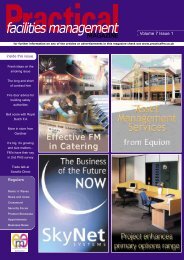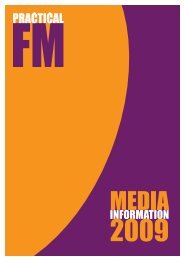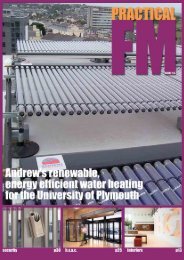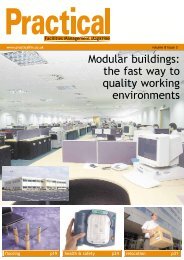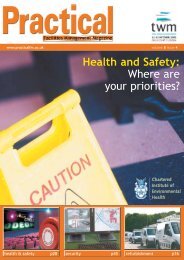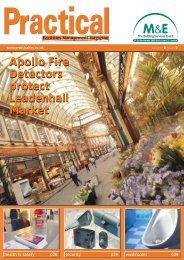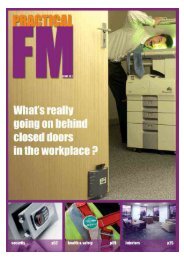KwikHEAT - Practical Facilities Management
KwikHEAT - Practical Facilities Management
KwikHEAT - Practical Facilities Management
- No tags were found...
Create successful ePaper yourself
Turn your PDF publications into a flip-book with our unique Google optimized e-Paper software.
h.v.a.c.How maintenance canenhance office AC performanceMaintenance implies keepingyear based on little more than the opinion of the maintaining system function than with individualequipment in the same condition. facilities engineer, plus some hazy idea of what component function.But there is a way to improve theperformance of an office’s airconditioning system – and therefore itsenergy consumption – by using aparticular maintenance technique. BillMcLaughlin, managing director ofDelrac ACS explainsThe pressing need to tackle climate change isincreasing pressure on facilities managers to reduceenergy consumption in the offices they manage.One of the biggest drains on energy in officescomes from the building services, and particularly airconditioning systems. Around 30 per cent of theenergy for air conditioning consumed in the UK is inoffices, which makes energy conservation a priorityin office blocks.But this begs a fundamental question: Whatmeasures can you take to reduce the voraciousappetite of air conditioning systems for power? Oneway is through effective maintenance.There are, essentially, three types of maintenance:Corrective – carried out to restore a defective item toa working condition as quickly as possible.Preventive – to ensure the best possible operationof equipment and avoid costly unplanned equipmentfailure or shutdown.Predictive – examining the “vital signs” of the systemthrough testing, inspection and “conditionmonitoring”.All are designed to preserve existing operatingconditions. However, there is a maintenance regimethat can actually improve a system’s performance.Reliability-centred maintenance (RCM) focuses onthe function rather than the equipment – in otherwords, what the system does rather than what it is.In his book, “Reliability-centred Maintenance”, JohnMoubray lists seven questions you should ask aboutthe “asset” (in our case the air conditioning system):What are the functions and associated performancestandards of the asset in its present operatingcontext?In what ways does it fail to fulfil its functions?What causes each functional failure?What happens when each failure occurs?In what way does each failure matter?What can be done to predict or prevent each failure?What should be done if a suitable proactive taskcannot be found?The development of RCM has re-definedmaintenance. It emphasises that the objectiveshould be to prevent or mitigate the consequencesof failures rather than to prevent the failuresthemselves.The consequences of failure differ depending onwhere and how air conditioning is installed andoperated. A formal review of failure consequenceswill focus attention on maintenance tasks that havemost effect, and diverts energy away from those thathave little or no effect.BSRIA’s view is that facilities managers faced withpoorly performing m&e services have to askthemselves: is it worth maintaining? This, says theAssociation, usually happens around the time of theannual budget process.It adds: “Faced with a lack of information on the truemaintenance needs of building services, a financialdirector is forced to set aside a sum of money everynasty things might happen to the business if thelights went out.“As a result, maintenance is usually based onpreserving the physical assets using failureprevention and asset care. However, such a strategymust add value to the business process. What’sneeded is a reliable way of assessing themaintenance needs of the services against thebusiness risk of plant failing in service.”BSRIA has produced a risk assessment toolkitdesigned to do just that. The Business FocussedMaintenance Toolkit enables facilities managers tofocus their maintenance activities based on a logicalassessment of risk to the business, says BSRIA.It concludes: “The Toolkit also provides a costeffectiveway to assess, manage and maintainservices, and reduces the risks of system failure.The result: maintenance that will protect yourbusiness without wasting money. The toolkitcontains everything you need to prepare a completemaintenance programme based on the risk to yourbusiness.”Five principles of RCMRCM defines failure as “any unsatisfactorycondition”. It may be either a loss of function (inother words, the air conditioning stops working) or aloss of acceptable quality (for example, the airconditioning continues, but fails to improve airquality).RCM can be used to gather data from the resultsachieved and feed this back to improve futuremaintenance. In other words, it can improve systemsand procedures and not simply keep them the same.The US-based “Whole Building Design Guide”defines RCM’s primary principles as:Function oriented – RCM seeks to preserve systemor equipment function, not just operability foroperability’s sake.System focused – RCM is more concerned withReliability centred – RCM is not overly concernedwith simple failure rate; it seeks to know theprobability of failure at specific ages.Design limitations – RCM’s objective is to maintainthe reliability of the equipment design recognisingthat changes in inherent reliability are the provinceof design rather than of maintenance. Maintenancecan, at best, only achieve and maintain the level ofreliability for equipment that was provided for bydesign. However, RCM recognises that maintenancefeedback can improve on the original design.Safety, security, and economics – Safety andsecurity must be ensured at any cost; thereafter,cost-effectiveness becomes the criterion.The need for good housekeepingRCM does not preclude the need for goodhousekeeping practice. The Carbon Trust alsorecommends the following general advice for airconditioning systems:Ideally, set timers so that there is no cooling whenthe building is unoccupied.Time-control each unit in localised cooling systemsto avoid out-of-hours operation.Check temperature settings. Find out thetemperature at which your air conditioning switcheson and your heating system switches off. Thegreater the temperature gap the better. Check andcompare temperature settings for each unit inlocalised air conditioning systems. The Carbon Trustsays it is common to see one unit heating andanother cooling in the same space.clean ductwork, fans and grilles regularly, andensure furniture doesn’t obstruct air pathways – anyblockage can increase energy consumption andmaintenance costs.By taking these measures, you will be reducing thechance of an air conditioning system failure. But,equally importantly, you will be helping to cut carbondioxide emissions from your buildings.Reader Reply No: 11104745



